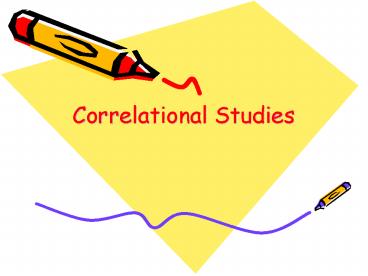Correlational Studies - PowerPoint PPT Presentation
Title:
Correlational Studies
Description:
Correlational Studies Types of correlation studies Correlation coefficient A positive correlation A negative correlation No correlation – PowerPoint PPT presentation
Number of Views:1205
Avg rating:3.0/5.0
Title: Correlational Studies
1
Correlational Studies
2
- the presence of a correlation does not indicate a
cause-effect relationship primarily - a minimum of 30 participants is acceptable
- larger samples are used if validity and
reliability are important
3
Types of correlation studies
- relationship studies
attempt to gain insight into variables that are
related to more complex variables
- prediction studies
conducted to test variables believed to be good
predictors of a criterion
4
Data analysis and interpretation
the two or more scores are obtained for each
member of the sample, and the paired scores are
then correlated
the correlation coefficient indicates the degree
of relationship between the variables of interest
5
Correlation coefficient
-1.00
1.00
0.00
strong positive
strong negative
no relationship
6
A positive correlation
y
x
7
A negative correlation
y
x
8
No correlation
y
x
9
No correlation
y
x
10
- The method for computing a correlation
coefficient
depends upon the type of data represented by
each variable
types of data
nominal (dichotomous)
interval (continuous)
ordinal (rank)
ratio (continuous)
11
Scatter plot
12
Measurement Scales
- Nominal scales allow for only qualitative
classification and have no arithmetic value. E.g.
gender, race, color, city, etc - Ordinal scales allow us to rank order the items
in terms of which has less and which has more but
still they do not allow us to say "how much
more." E.g. Likert scale, class rank, letter
grade - Interval variables allow us not only to rank
order the items that are measured, but also to
quantify and compare the sizes of differences
between them. E.g. temperature, test scores. - Ratio scales are like interval scales but they
feature an identifiable absolute zero point,
thus, they allow for statements such as x is two
times more than y. E.g. age, height, weight.
(Most statistical data analysis procedures do not
distinguish between the interval and ratio
scales).
13
- with continuous data
use the product moment correlation, Pearson r
(?, rho)
- with rank data
use the rank difference correlation, Spearman r
(?, rho)
14
- with dichotomous data
use the phi correlation (?)
- with curvilinear data
use the eta correlation (?)































